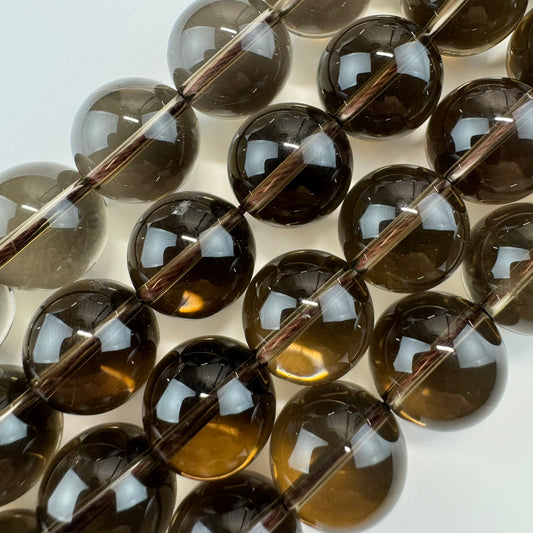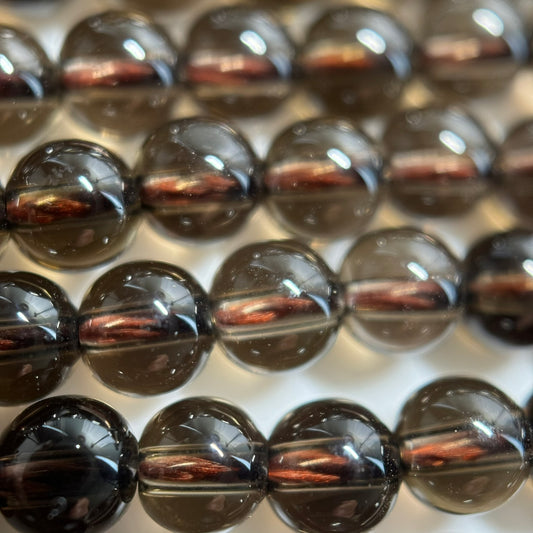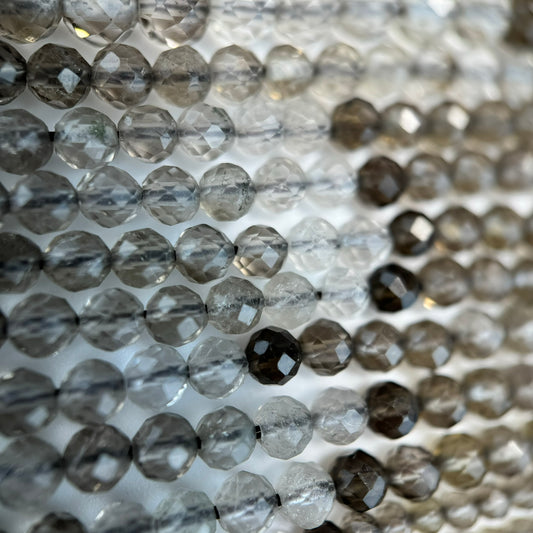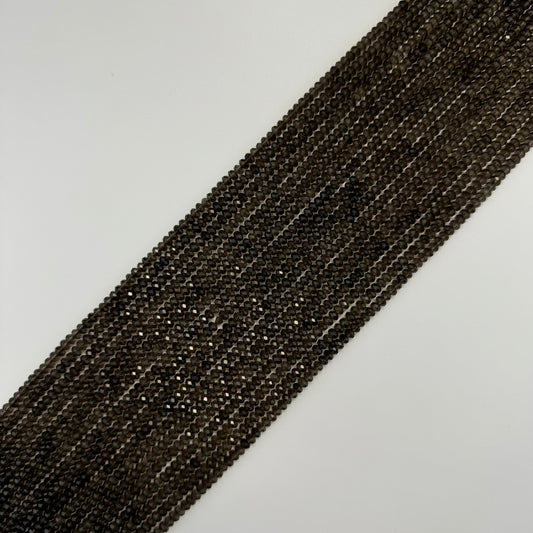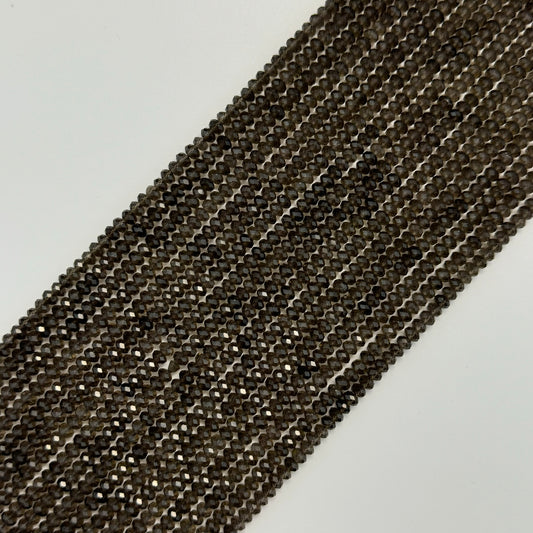Smoky Quartz Gemstone Beads
Introduction to Smoky Quartz Gemstone Beads
Smoky Quartz is a variety of quartz distinguished by its brown to black coloration, resulting from natural radiation exposure. This popular gemstone combines the durability of quartz with distinctive earthy colors, making it ideal for various jewelry applications.
Key Characteristics
- Brown to black coloration
- Transparent to translucent
- Mohs hardness of 7
- Excellent durability
- Widely available
Chemical Composition and Color Origin
Smoky Quartz consists of silicon dioxide (SiO2) like all quartz varieties. Its distinctive color comes from natural radiation exposure that creates color centers in the crystal structure.
Composition and Color
- Chemical formula: SiO2
- Color origin: Natural radiation
- Color centers: Aluminum impurities
- Crystal system: Trigonal
- Specific gravity: 2.65
Formation and Geological Processes
Smoky Quartz forms in various geological environments where quartz crystals are exposed to natural radiation sources, typically from surrounding rocks containing radioactive elements.
Formation Environments
- Pegmatite environments
- Hydrothermal veins
- Metamorphic rocks
- Areas with radioactive minerals
- Extended exposure periods
Color Variations and Intensity
Smoky Quartz displays a range of brown to black tones, with color intensity varying based on radiation exposure duration and intensity.
Color Spectrum
- Light brown (cairngorm)
- Medium brown tones
- Dark brown
- Nearly black (morion)
- Color zoning may occur
Cutting and Enhancement Techniques
Smoky Quartz takes excellent cuts and polishes well. The stone can be faceted or cut as cabochons, with faceted cuts showcasing its transparency.
Cutting Considerations
- Faceted cuts showcase transparency
- Cabochon cuts for uniform color
- Various shapes possible
- Excellent polish quality
- Bead shapes work well
Hardness and Durability Properties
With a Mohs hardness of 7, Smoky Quartz offers excellent durability for jewelry use. It's suitable for everyday wear.
Durability Factors
- Mohs hardness: 7 (excellent)
- Good resistance to scratching
- No cleavage planes
- Stable under normal conditions
- Ideal for everyday jewelry
Geographic Sources and Availability
Smoky Quartz occurs in many locations worldwide, with notable sources in Brazil, Switzerland, Scotland, and various other countries.
Primary Sources
- Brazil: Large commercial deposits
- Switzerland: Alpine sources
- Scotland: Cairngorm variety
- United States: Various locations
- Madagascar: Quality material
Care and Maintenance Practices
Smoky Quartz requires standard quartz care practices. The stone is durable and easy to maintain.
Care Guidelines
- Clean with warm soapy water
- Ultrasonic cleaning safe
- Store separately to prevent scratching
- Standard jewelry care
- Occasional polishing restores shine
Jewelry Design Applications
Smoky Quartz beads create versatile jewelry pieces suitable for various styles. The stone's neutral colors complement many design aesthetics.
Design Uses
- Strand necklaces
- Bracelets and earrings
- Men's and women's jewelry
- Contemporary and traditional styles
- Combinations with other stones
Historical and Cultural Significance
Smoky Quartz has been used in jewelry for centuries, with particular significance in Scottish culture where it's known as cairngorm.
Historical Uses
- Scottish traditional jewelry
- Victorian era popularity
- Ancient decorative uses
- Modern commercial applications
- Collector interest
Metaphysical Properties and Symbolism
Smoky Quartz holds significance in various metaphysical traditions, associated with grounding, protection, and transformation.
Symbolic Meanings
- Grounding and stability
- Protection from negative energy
- Transformation and change
- Emotional healing
- Connection to earth energy
Comparison with Related Quartz Varieties
Smoky Quartz belongs to the quartz family alongside other colored varieties. Understanding its relationship helps in identification.
Related Varieties
- Clear Quartz: No color
- Amethyst: Purple variety
- Citrine: Yellow variety
- Rose Quartz: Pink variety
- All share same basic structure
Frequently Asked Questions
What is the chemical composition and what causes the smoky color in Smoky Quartz?
Smoky Quartz has the chemical formula SiO2 (silicon dioxide), identical to all quartz varieties. The smoky brown to black coloration results from natural irradiation of the crystal structure, which creates color centers involving aluminum impurities. The aluminum atoms substitute for silicon in the crystal lattice, and when exposed to natural radiation, they trap electrons, creating the characteristic smoky color.
What is the Mohs hardness and how does it compare to other quartz varieties?
Smoky Quartz has a Mohs hardness of 7, identical to all quartz varieties including amethyst, citrine, and clear quartz. This hardness makes it durable for jewelry use and resistant to scratching from most common materials. The uniform hardness throughout the crystal makes it reliable for cutting and polishing.
What causes the variation in color intensity from light brown to nearly black in Smoky Quartz beads?
Color intensity depends on the concentration of aluminum impurities and the duration and intensity of natural irradiation. Light smoky quartz has lower aluminum content or less irradiation exposure, while very dark (morion) quartz has higher aluminum content and more extensive irradiation. The color can also vary within a single crystal, creating zoning or gradients.
What is the relationship between Smoky Quartz and other colored quartz varieties?
Smoky Quartz is related to Amethyst (purple quartz, colored by iron and irradiation), Citrine (yellow quartz, colored by iron and heat), and Rose Quartz (pink quartz, colored by titanium or manganese). All share the same crystal structure and chemical composition (SiO2) but differ in the type and concentration of color-causing impurities and their treatment.
What are the primary geological sources and formation conditions of Smoky Quartz?
Smoky Quartz forms in pegmatites, hydrothermal veins, and other igneous and metamorphic environments where quartz crystallizes. Major sources include Brazil, Switzerland (particularly the Alps), Scotland, the United States (Colorado, Maine), Madagascar, and Russia. The material requires natural radiation sources (often from surrounding rocks) to develop its color.
What is the specific gravity and refractive index of Smoky Quartz?
Smoky Quartz has a specific gravity of 2.65, identical to all quartz varieties. Its refractive index is approximately 1.544-1.553, with birefringence of 0.009. These optical properties are consistent across all quartz varieties regardless of color, as the color comes from structural defects rather than different chemical composition.
Can Smoky Quartz be artificially created or enhanced through irradiation?
Yes, Smoky Quartz can be artificially created by irradiating clear quartz with high-energy radiation (gamma rays, X-rays, or electron beams). Natural and artificial irradiation produce identical results, making it difficult to distinguish without advanced testing. However, naturally colored material is often preferred, and some artificially treated material may fade over time if not properly stabilized.
What causes the color zoning sometimes seen in Smoky Quartz beads?
Color zoning results from variations in aluminum concentration or irradiation exposure during crystal growth. Different growth zones may have different impurity levels, and if irradiation occurred at different times or intensities, it creates bands of varying color intensity. This zoning is natural and can add visual interest to the beads.
How does Smoky Quartz's transparency affect its use in jewelry?
Smoky Quartz ranges from transparent to nearly opaque, depending on color intensity. Lighter specimens are more transparent and show good clarity, while very dark (morion) specimens may be nearly opaque. The transparency allows for faceting to maximize brilliance, and the material can be cut in various styles to enhance its appearance.
What is the difference between Smoky Quartz and Morion?
Morion is the very dark, nearly black variety of Smoky Quartz. The distinction is based on color intensity—morion is so dark it appears black, while lighter varieties are brown or gray-brown. Both are the same mineral (quartz) with the same cause of color (aluminum and irradiation), differing only in the intensity of the color centers.
How should Smoky Quartz beads be cleaned and maintained?
Clean Smoky Quartz beads with warm, soapy water and a soft brush or cloth. The material is stable and can withstand normal cleaning methods. Avoid harsh chemicals that could potentially affect the color centers, and protect from prolonged exposure to strong sunlight, which can cause fading in some artificially treated specimens.
What makes Smoky Quartz beads suitable for everyday jewelry wear?
Smoky Quartz's hardness of 7, good durability, stability, and attractive color make it excellent for everyday jewelry. It's resistant to scratching, doesn't require special care, and maintains its appearance well. The material is also relatively affordable compared to many other gemstones, making it accessible for regular wear.
How does the color of Smoky Quartz compare to other brown gemstones?
Smoky Quartz offers a unique brown-gray color that's distinct from other brown gemstones. It differs from brown tourmaline in its crystal structure and optical properties, from brown topaz in its hardness and formation, and from brown zircon in its density and optical characteristics. Smoky Quartz's transparency and quartz properties help distinguish it.
What cutting styles work best with Smoky Quartz beads?
Smoky Quartz can be cut in various styles depending on the color intensity. Lighter, more transparent specimens work well with faceted cuts that maximize brilliance. Darker specimens may be cut as cabochons or beads to showcase the color. The material takes an excellent polish and works well in both traditional and modern cutting styles.
What are the quality factors that affect the value of Smoky Quartz beads?
High-quality Smoky Quartz beads feature uniform color distribution, good clarity (for lighter specimens), attractive color intensity, and minimal inclusions or fractures. The most valued specimens have a rich, even brown color without excessive darkness that would make them appear black. Well-cut beads with good polish and attractive color command higher values.


